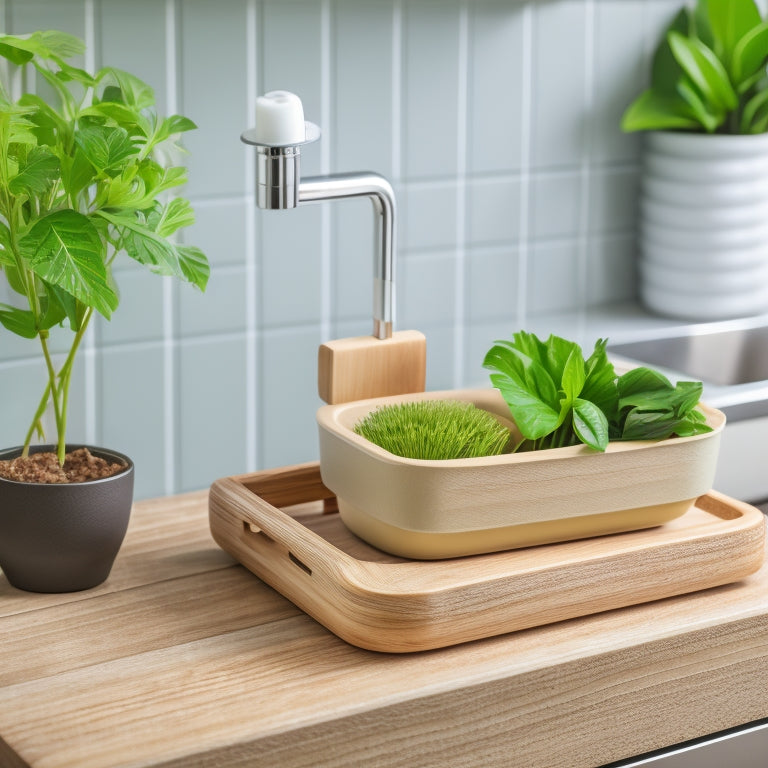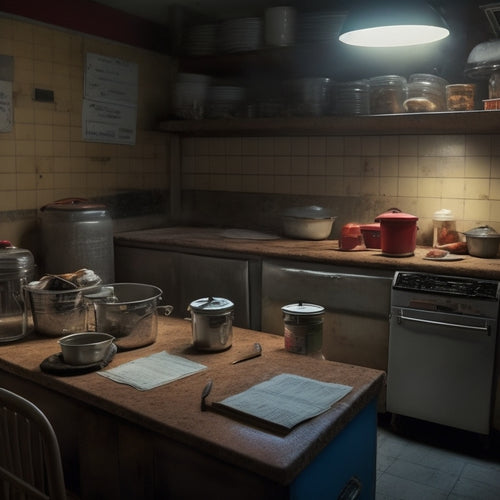
Create a DIY Sink Caddy for Kitchen Utensils
Share
You're about to transform the cluttered space under your kitchen sink into a sleek, functional haven for your kitchen utensils with a DIY sink caddy. Gather essential materials like a sturdy wire shelf, wooden dowel rods, and a hot glue gun. Measure your sink space carefully, considering length, width, and depth, as well as corner space and edge clearance. Cut a 1x4 lumber into four 12-inch pieces for the base, and assemble the frame with vertical supports. Attach utensil holders, then install the caddy securely under the sink. Now you're ready to take your DIY sink caddy to the next level!
Key Takeaways
• Measure sink space precisely, focusing on corner space, edge clearance, and sink basin dimensions for a snug caddy fit.
• Cut a sturdy base from 1x4 lumber and assemble the frame with vertical supports, ensuring corner stability and durability.
• Attach utensil holders with a drill, screws, and level, considering holder placement for organization and even spacing.
• Install the caddy securely under the sink, using a socket wrench and aligning the base plate with sink mounting points.
• Customize the caddy design with storage compartments, ergonomic design, and decorative accents to suit your kitchen style and needs.
Gathering Essential Materials
Gather a sturdy wire shelf, a few wooden dowel rods, a hot glue gun, and some basic crafting tools to get started on your DIY sink caddy project. These materials will provide a solid foundation for your caddy, and you can always adjust or add to them as needed.
When it comes to material options, consider what'll work best for your kitchen style and the items you want to store. For a rustic look, opt for wooden dowel rods, while a wire shelf will give your caddy a modern feel.
Keep in mind your budget constraints when selecting materials. You can find affordable options at your local hardware store or online. If you're on a tight budget, repurpose items you already have at home, like an old picture frame or a wooden crate. Get creative and think outside the box!
With a little imagination, you can create a functional and stylish sink caddy that fits your kitchen's unique vibe.
Measuring Your Sink Space
Now it's time to get out your measuring tape and take a close look at your sink space!
You'll want to measure the length, width, and depth of your sink to determine the perfect size for your caddy.
Sink Dimensions Matter
Measuring your sink space accurately is crucial, as it determines the maximum size of your DIY sink caddy, so grab your tape measure and let's get started! You want to guarantee your caddy fits snugly without obstructing your sink's functionality.
Here are three key areas to focus on when measuring your sink space:
-
Corner space: Measure the width and depth of the corners where you plan to place your caddy. This will help you determine the maximum size of your caddy's corners.
-
Edge clearance: Measure the distance between the sink's edge and any surrounding countertops or cabinets. You'll want to leave enough clearance for easy access to your sink and utensils.
-
Sink basin dimensions: Measure the length, width, and depth of your sink basin to determine the maximum size of your caddy.
When taking these measurements, consider the layout of your sink and the utensils you want to store. Visualize how your caddy will fit and function in the space.
Measure Twice Correctly
How accurately can you visualize your DIY sink caddy fitting into the available space if you haven't taken precise measurements? You can't rely on guesswork when it comes to creating a functional and space-efficient sink caddy. Precision matters, and it starts with measuring your sink space accurately.
Take out your measuring tape and get to work. Measure the width, length, and depth of your sink, as well as the distance between the faucet and the edge of the sink. Don't forget to note the location of any obstructions, such as pipes or soap dispensers.
Double checking your measurements is vital to ensure accuracy. Write down each measurement carefully, and double-check them against each other to catch any errors.
Space Available Analysis
What's the maximum amount of space you can realistically dedicate to your sink caddy, considering the sink's dimensions and any obstructions in the area? Take a closer look at your sink's layout and identify the available space. Think about the corners, edges, and any gaps between the sink and surrounding countertops or walls.
Here are three key areas to focus on:
-
Corner utilization: Make the most of the often-wasted space in the corners of your sink. A well-designed caddy can fit snugly into these areas, providing ample storage for utensils and other items.
-
Vertical optimization: Consider the vertical space above your sink, from the countertop to the upper cabinets or ceiling. A tiered or wall-mounted caddy can maximize this space, keeping your countertops clear and organized.
-
Edge efficiency: Look at the edges of your sink, where it meets the countertop or walls. A slim caddy or utensil holder can fit along these edges, providing additional storage without taking up too much space.
Cutting the Caddy Base
With your materials ready, grab your saw and start cutting the 1x4 lumber into four pieces, each 12 inches long, to form the base of your sink caddy. For this task, you'll want to choose a saw that's suitable for the job, like a circular saw or a miter saw.
When it comes to tool selection, keep in mind that a high-quality saw will make the cutting process smoother and more accurate. As you cut the lumber, bear in mind that you want your caddy base to be sturdy and durable. That's why it's crucial to select materials that can withstand the weight of your kitchen utensils and the humidity of the sink area.
The 1x4 lumber is a great choice because it's strong, yet lightweight, and can resist warping or cracking over time. Once you've cut all four pieces, take a moment to inspect them for any imperfections or splinters. Sand them down if necessary to guarantee a smooth surface.
Now, you're ready to move on to the next step and start assembling your caddy frame. But for now, take pride in the fact that you've completed the first major step in creating your DIY sink caddy!
Assembling the Caddy Frame
Now that you've got your four base pieces cut and sanded, you're ready to start building the frame of your sink caddy by attaching the vertical supports. This is where your design starts to take shape, and you'll be excited to see your project come together.
To guarantee a sturdy frame design, focus on corner stability by using the right type of joints. You'll want to create a solid foundation for your utensil holders, so take your time and make sure each connection is secure.
Here are three key tips to keep in mind when assembling your caddy frame:
-
Use a level: Make sure your vertical supports are perfectly straight and your frame is level.
-
Choose the right joints: Opt for corner brackets or screws that can hold the weight of your utensils and withstand daily use.
-
Measure twice, attach once: Double-check your measurements before attaching the vertical supports to avoid any mistakes.
Attaching the Utensil Holders
You'll add functionality to your sink caddy by attaching the utensil holders, which will keep your kitchen essentials organized and within easy reach. To get started, gather your tool selection, including a drill, screws, and a level. This will guarantee that your holders are securely attached and evenly spaced.
Next, decide on the holder placement that works best for you. Consider the size and shape of your utensils, as well as the layout of your sink area. You may want to place larger holders near the front of the caddy for easy access to frequently used items, and smaller holders towards the back for less frequently used items.
Once you've determined the placement, use your drill to screw the holders into place. Make sure they're level and evenly spaced to create a visually appealing and functional design.
As you attach each holder, imagine the satisfaction of having all your kitchen essentials organized and within reach. With your utensil holders securely in place, you're one step closer to a clutter-free kitchen that feels like your own.
Adding a Drainage System
By incorporating a drainage system into your sink caddy, water and debris will flow freely, keeping your kitchen utensils dry and preventing water spots.
Now, let's get hands-on! To create an efficient drainage system, focus on the following key elements:
-
Drainage Holes:
Drill holes at the bottom of your caddy to allow water to flow out. Make sure they're not too large, or utensils might fall through! -
Water Flow:
Design the caddy's surface to guide water towards the drainage holes. A slight incline or curved surface can do the trick. -
Water Channel:
Create a small channel or groove to direct water towards the drainage holes. This safeguards water doesn't pool around your utensils.
Installing the Sink Caddy
You've made it to the final stretch - it's time to install your sink caddy!
First, you'll need to assemble the caddy itself, making sure all the parts fit together snugly.
Then, you'll mount it securely under your sink, ensuring it's level and ready to hold your kitchen utensils.
Caddy Assembly Required
Hold the sink caddy's base plate against the edge of your sink, making sure it's centered and the screw holes align with the sink's mounting points.
Take a step back to admire your handiwork – you're one step closer to having a clutter-free kitchen!
Assembly Essentials:
- Socket wrench for a secure grip on those screws
- Level to guarantee your caddy's straight and level
- Measuring tape for double-checking those screw holes
Now, let's talk tool preferences. If you're a DIY enthusiast, you might've a favorite socket wrench that's served you well in previous projects. If not, don't worry – a basic one will do the trick.
When it comes to assembly shortcuts, consider enlisting the help of a friend or family member to hold the caddy in place while you screw it in. This will save you time and energy in the long run.
With these essentials and tips in mind, you're ready to move forward with the assembly process.
Mounting the Caddy
Now that your caddy's base plate is positioned perfectly, it's time to secure it to the sink with screws. Make sure to predrill holes in the sink's underside to avoid damaging the surface. Use wall anchors to provide extra grip and stability, especially if you have a tile or granite sink.
| Mounting Option | Description | Hardware Needed |
|---|---|---|
| Corner Brackets | Attach the caddy to the sink's corner for maximum stability | 2 corner brackets, 4 screws |
| Wall Anchors | Add extra grip to the caddy's base plate | 2 wall anchors, 2 screws |
| Suction Cups | Perfect for renters or those who don't want to drill holes | 2 suction cups |
| Adhesive Strips | A strong and removable option | 2 adhesive strips |
| Clamp Mount | Attach the caddy to the sink's rim for a secure fit | 1 clamp mount, 2 screws |
Choose the mounting option that best suits your sink type and personal preference. Follow the manufacturer's instructions for each hardware type, and make sure the caddy is level and secure before loading it with utensils. With your caddy securely in place, you'll be enjoying a clutter-free kitchen in no time!
Customizing Your Caddy Design
With your sink caddy's basic structure in place, start thinking about the layout and features that'll make it a perfect fit for your kitchen utensils and workflow. Now it's time to infuse your personal style into the design.
Consider the color scheme that'll complement your kitchen's aesthetic. Will you opt for a bold and bright hue or a more subtle, neutral tone? Think about the materials and textures you'll use to add depth and visual interest.
Here are three key elements to focus on:
-
Storage compartments: Will you need separate slots for utensils, cleaning supplies, or dish soap?
-
Ergonomic design: Consider the height and angle of your caddy to guarantee comfortable use.
-
Decorative accents: Add a personal touch with decorative trim, paint, or stickers that reflect your style.
As you customize your caddy, remember to prioritize functionality and ease of use. You want your DIY sink caddy to be a reflection of your personal style, but also a practical solution for your kitchen needs.
Frequently Asked Questions
Can I Use a Pre-Made Caddy Base Instead of Building One From Scratch?
"You can totally use a pre-made caddy base and still get creative! Think caddy customization with upcycled materials - add your personal touch and make it yours, without building from scratch."
How Do I Clean the Utensil Holders to Prevent Bacterial Growth?
"Did you know 70% of kitchen utensils harbor bacteria? You'll want to establish a sanitizing routine for your utensil holders, washing them with soap and warm water daily, and doing a deep clean weekly, as part of your regular maintenance, to keep germs at bay."
Are There Any Alternative Materials to PVC Pipes for the Frame?
You're looking for alternatives to PVC pipes, right? Consider copper frames for a sleek, modern vibe or wooden dowels for a rustic touch – both are durable and easy to clean, perfect for your DIY project!
Can I Add a Utensil Holder for a Specific Kitchen Tool I Use Often?
You're like a master chef, always whipping up a storm in the kitchen! You can easily add a custom holder for that trusty tool, creating specialized storage that keeps it within arm's reach, making your cooking routine a breeze.
Will the Sink Caddy Obstruct the Sink's Garbage Disposal Functionality?
You'll want to make sure your DIY sink caddy doesn't compromise sink clearance or cause disposal interference. Measure carefully to avoid obstructing the disposal's spinning blades and maintain smooth sink functionality.
Related Posts
-

Discover Luxurious Self-Care Essentials at Foundry Home
At Foundry Home, discover a curated world of luxurious self-care essentials, expertly designed to elevate relaxation ...
-

Transformative Techniques and Innovations in Mud Building
You're about to discover the cutting-edge of mud building, where ancient techniques meet modern innovations. Revoluti...
-

Food Safety Inspections Uncover Startling Violations
Food safety inspections in local establishments have uncovered a disturbingly high number of critical violations, put...


